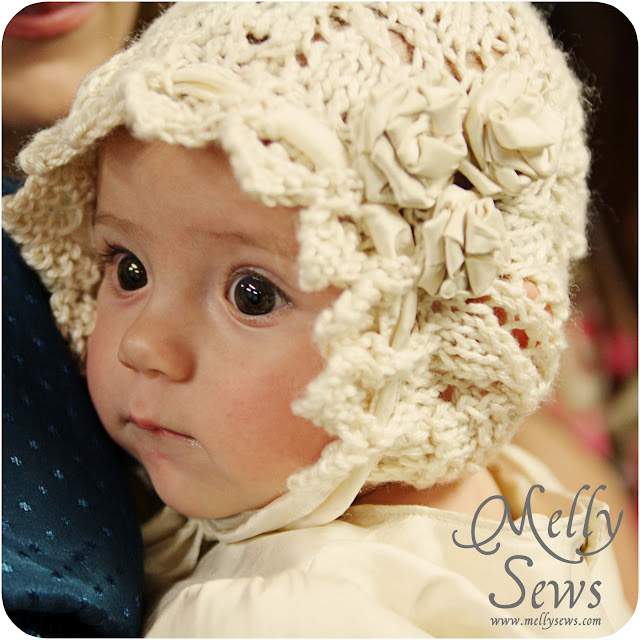FR633/J601 A continuation of this post.
So, once we opened the door to knitting, Mr. Thomas (one of our fine commenters) pointed out that every aspect of this poem can be construed as a knitting double-entendre. But, before going where this leads, let’s all agree that Emily Dickinson did not have a sense of humor, did not do anything other than sit in her room all day contemplating moldering death, and would never demean the genius of poetry with a tawdry poem that might be, in its entirety, inspired by a knit cap. Great artists do not have a sense of humor. and do not trifle their genius with knit caps. With that out of the way, the poem again:
I saw no Way — The Heavens were stitched — I felt the Columns close — The Earth reversed her Hemispheres — I touched the Universe — And back it slid — and I alone — A Speck upon a Ball — Went out upon Circumference — Beyond the Dip of Bell —
And now for the double-entendres:
- Heavens → According to the Oxford English Dictionary, the 19th century usage of this word included the meaning “canopy”, as over a stage.
- stitched → stitched/knitted
- columns → column stitch
- Earth reversed → Right side/Wrong side: The “right side” of the work is the side that faces out or toward the public. This would be the outside of a hat, sweater, mittens. On a flat project like a blanket it is the side that is intended to show the pattern. The “wrong side” refers to the inside of the work, the back of the work or the part that doesn’t face the public. Knitting for Beginners
- Hemispheres → the inside and outside of a knit cap/hat/bonnet
- Universe → The world or earth, esp. as the place of abode of mankind or as the scene of human activities. [Oxford English Dictionary, emphasis mine.]
- And back it slid → Could be a reference to needles sliding or putting on a knit hat (let’s say).
- Ball → A ball of yarn.
- Circumference → Any given hat has a circumference.
- Dip → Dickinson might, for instance, use a double dip stitch whilst knitting a hat.
- Bell → And she might also use a Bell Lace Stitch in the same hat.
So what to make of this? Imagine Dickinson sitting in the livingroom, by the fire perhaps, while here relatives are also knitting or simply bustling about the house. As she knits her hat/cap/toboggan/bonnet, and being in a light mood, she stops knitting long enough to feel the hat’s soft material between her fingers and begins (with the eye of poetic genius) to think that the hat would make a lovely metaphor. Or imagine that she pauses, knit hat in hand, before putting it on to go outside.
First she looks at the inside of the hat.
I saw no Way — The Heavens were stitched —

She saw no way through the top of the cap. And that’s how a knit cap is supposed to look. Maybe she’s finished the hat by turning it inside out and tying off the last top stitches. From Knitmuch: “When you’re satisfied they are secure, pull the needle through to the inside of the hat and weave the yarn through a few stitches on the wrong side of the work. Tie a knot and cut the yarn, leaving a short end.” Or maybe she’s simply looking at the “wrong side” of the hat—the inside—and naturally enough the Heavens—the top of the cap—are stitched together and there’s “no way” through.
The Heavens are the top of the hat—and of course the hat itself—in the sense of a canopy for the head, the head and mind being the stage where our lives play out. This interpretation relies on synecdoche but Dickinson is nothing if not a master synecdoche.
I felt the Columns close —
She feels the column stitch closely, perhaps for the pleasure of feeling the finished cap, but also playing on the sense of enclosure (of the columns on a stage perhaps). There might also be the sense of her feeling the column stitches close at the top of the hat.
The Earth reversed her Hemispheres —
She turns the hat inside out. Passive tense: The Earth [the hat reversed itself/herself] her Hemispheres. A hat, after all, is hemispherical. And the hat is like an Earth in that it contains us, in a sense, and is the circumference beyond which the universe awaits. Here too Dickinson might be playing on the sense of turning dogma and religious doctrine inside out. Both interpretations of this poem can exist side by side. That’s the beauty of poetry.
I touched the Universe —
The inside of the hat is the canopy (Heavens) beneath which our cognitive drama plays out. The hat goes on our head and our head is enclosed in the hat’s “columns” much as a stage might be enclosed. The outside of the hat is the “Universe” or—perhaps better—the outside of the hat is where the universe begins—the abode of mankind. So, in a sense, by touching the outside of her knit cap, she’s touching the universe. Dogma is on the “wrong side” and the universe is on the “right side”—the public side.
And back it slid — and I alone —
She puts the cap on—back it slid—and goes outside/into the universe alone. Simple as that. There’s a feeling of loneliness but also the pleasure of being alone, free from the constraints of others—their dogmas, philosophies, and religious impositions. She goes out alone, unaccompanied by preconceptions, mind fully open to any experience.
A Speck upon a Ball —
And now she playfully compares the Earth to a ball of yarn and herself as, perhaps, a speck of color on that great “Ball”.
Went out upon Circumference —
She went for a walk. Simple as that. The circumference of her hat was both the circumference of her own being and the beginning of the Universe. And the circumference is that of the Earth, the ball of yarn she walks upon. There’s the sense, perhaps, that Dickinson thinks of the Earth as a great Ball of yarn with which she’ll knit her own understanding of the Universe.
Beyond the Dip of Bell —
An understanding that goes far beyond the Dip and Bell stitch—the commonplace conceptions of others—and the columns. She will knit, from the yarn of Earth, an entirely individual and original conception of the universe. She doesn’t write Dip and Bell but Dip of Bell, which is why it’s not unreasonable to read it as a reference to the swinging peal and call of a church bell with all its dogma and doctrine. {Edit: Given the tactile emphasis of the poem, “Dip of Bell” may also refer to the tactile dip the bell stitch can make in the pattern). The line can contain both meanings, and Dickinson is going to walk beyond both.
up in Vermont | November 16 2023







